Detailed Business Development Plan for Organioria Restaurant, Canada
VerifiedAdded on 2022/08/20
|11
|2786
|12
Report
AI Summary
This report presents a detailed business development plan for "Organioria," a proposed organic restaurant in Toronto, Canada. The plan outlines the business overview, including its organic food concept, mission, and objectives. It covers the business's ownership structure, target market (premium class, health-conscious individuals, and tourists), and competitive advantages such as unique food offerings and high-quality service. The report includes a comprehensive market analysis, detailing customer needs and trends, and a marketing plan with pricing, promotion, and place strategies. A competitive analysis highlights the restaurant's strengths, weaknesses, opportunities, and threats. The organizational structure, startup expenses, and financial considerations are also addressed. The conclusion summarizes the plan's key elements, emphasizing the focus on providing high-quality organic food to a target audience. This document, contributed by a student, is available on Desklib, a platform offering AI-based study tools for students.

Business Model
Student’s Details
Student’s Details
Paraphrase This Document
Need a fresh take? Get an instant paraphrase of this document with our AI Paraphraser
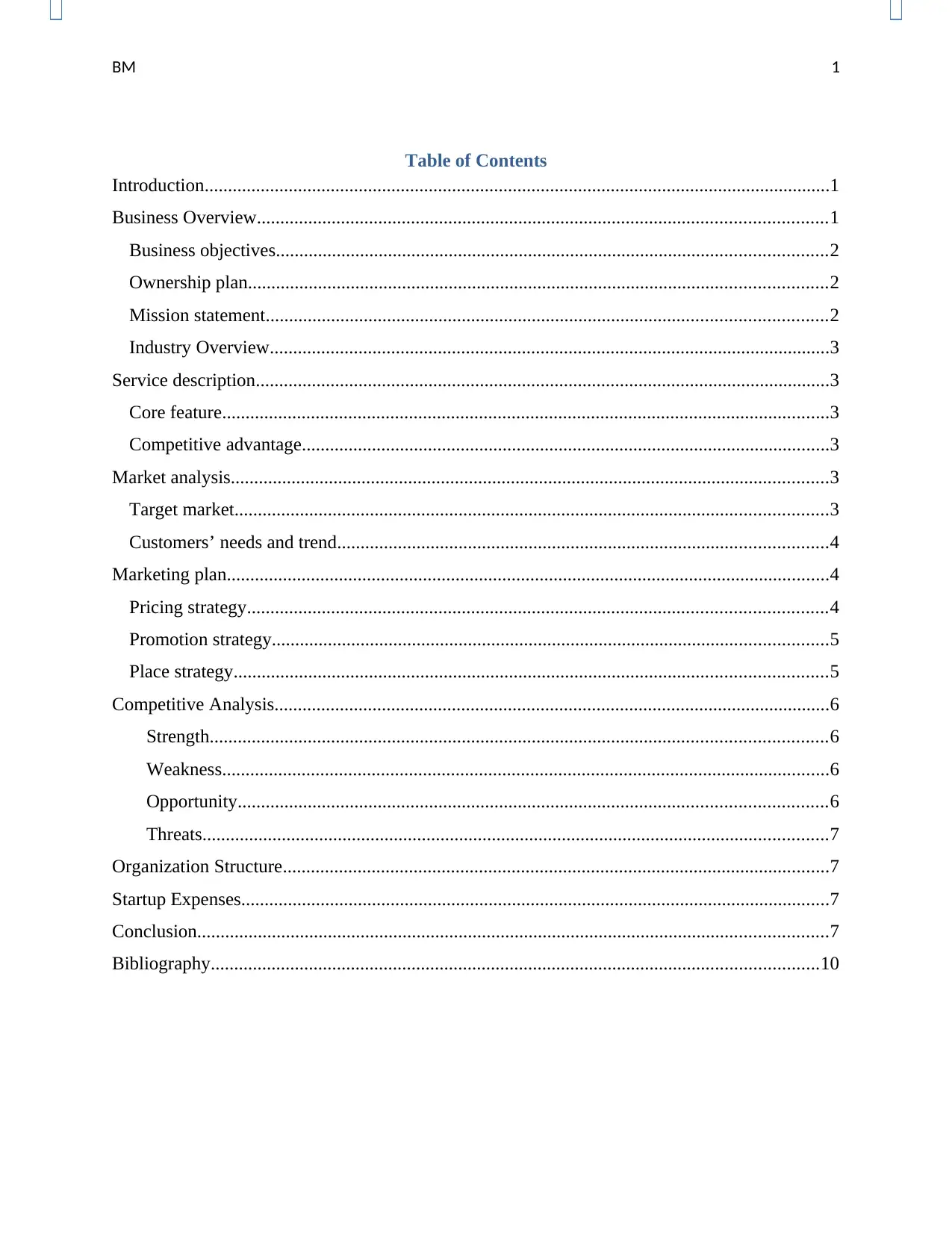
BM 1
Table of Contents
Introduction......................................................................................................................................1
Business Overview..........................................................................................................................1
Business objectives......................................................................................................................2
Ownership plan............................................................................................................................2
Mission statement........................................................................................................................2
Industry Overview........................................................................................................................3
Service description...........................................................................................................................3
Core feature..................................................................................................................................3
Competitive advantage.................................................................................................................3
Market analysis................................................................................................................................3
Target market...............................................................................................................................3
Customers’ needs and trend.........................................................................................................4
Marketing plan.................................................................................................................................4
Pricing strategy............................................................................................................................4
Promotion strategy.......................................................................................................................5
Place strategy...............................................................................................................................5
Competitive Analysis.......................................................................................................................6
Strength....................................................................................................................................6
Weakness..................................................................................................................................6
Opportunity..............................................................................................................................6
Threats......................................................................................................................................7
Organization Structure.....................................................................................................................7
Startup Expenses..............................................................................................................................7
Conclusion.......................................................................................................................................7
Bibliography..................................................................................................................................10
Table of Contents
Introduction......................................................................................................................................1
Business Overview..........................................................................................................................1
Business objectives......................................................................................................................2
Ownership plan............................................................................................................................2
Mission statement........................................................................................................................2
Industry Overview........................................................................................................................3
Service description...........................................................................................................................3
Core feature..................................................................................................................................3
Competitive advantage.................................................................................................................3
Market analysis................................................................................................................................3
Target market...............................................................................................................................3
Customers’ needs and trend.........................................................................................................4
Marketing plan.................................................................................................................................4
Pricing strategy............................................................................................................................4
Promotion strategy.......................................................................................................................5
Place strategy...............................................................................................................................5
Competitive Analysis.......................................................................................................................6
Strength....................................................................................................................................6
Weakness..................................................................................................................................6
Opportunity..............................................................................................................................6
Threats......................................................................................................................................7
Organization Structure.....................................................................................................................7
Startup Expenses..............................................................................................................................7
Conclusion.......................................................................................................................................7
Bibliography..................................................................................................................................10
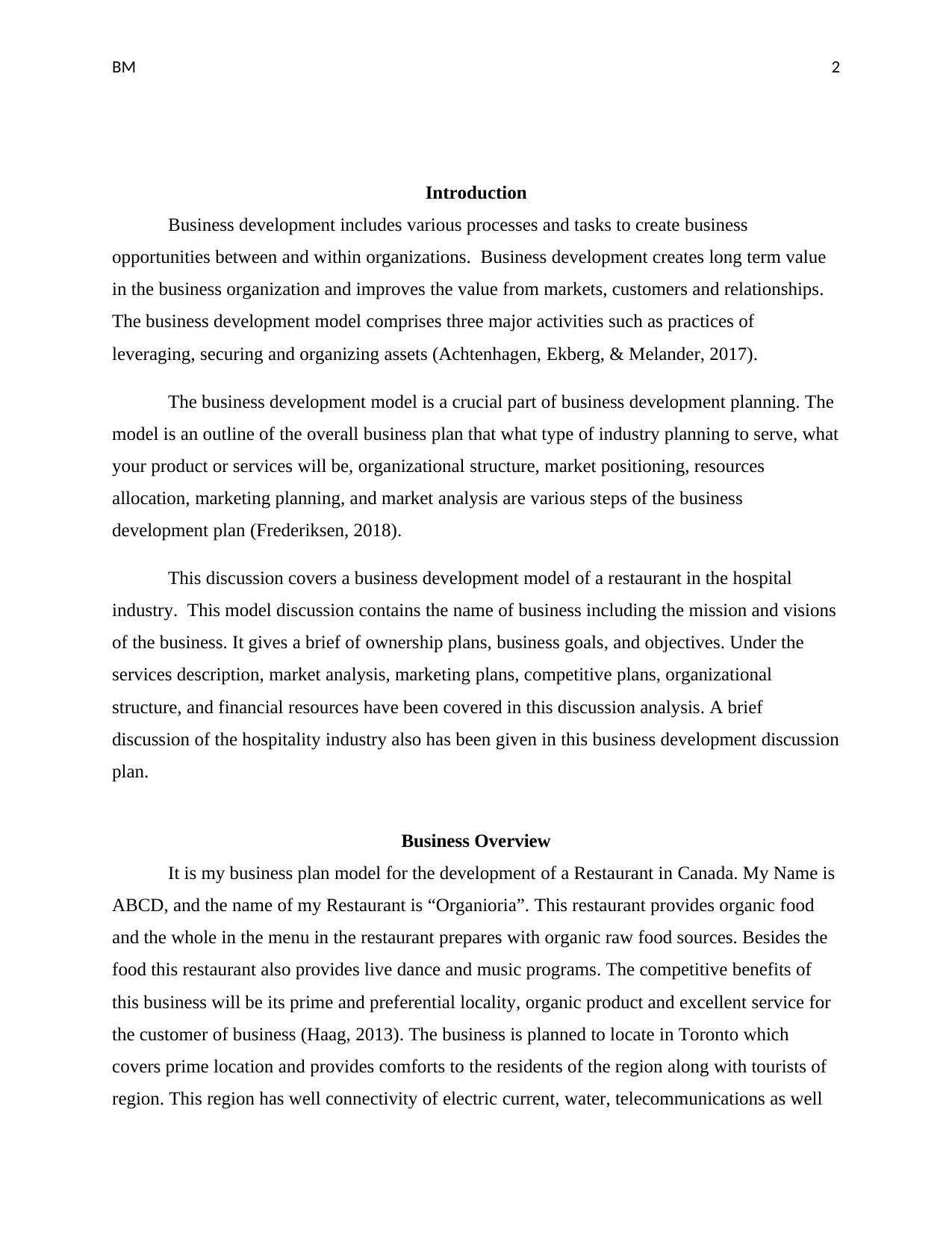
BM 2
Introduction
Business development includes various processes and tasks to create business
opportunities between and within organizations. Business development creates long term value
in the business organization and improves the value from markets, customers and relationships.
The business development model comprises three major activities such as practices of
leveraging, securing and organizing assets (Achtenhagen, Ekberg, & Melander, 2017).
The business development model is a crucial part of business development planning. The
model is an outline of the overall business plan that what type of industry planning to serve, what
your product or services will be, organizational structure, market positioning, resources
allocation, marketing planning, and market analysis are various steps of the business
development plan (Frederiksen, 2018).
This discussion covers a business development model of a restaurant in the hospital
industry. This model discussion contains the name of business including the mission and visions
of the business. It gives a brief of ownership plans, business goals, and objectives. Under the
services description, market analysis, marketing plans, competitive plans, organizational
structure, and financial resources have been covered in this discussion analysis. A brief
discussion of the hospitality industry also has been given in this business development discussion
plan.
Business Overview
It is my business plan model for the development of a Restaurant in Canada. My Name is
ABCD, and the name of my Restaurant is “Organioria”. This restaurant provides organic food
and the whole in the menu in the restaurant prepares with organic raw food sources. Besides the
food this restaurant also provides live dance and music programs. The competitive benefits of
this business will be its prime and preferential locality, organic product and excellent service for
the customer of business (Haag, 2013). The business is planned to locate in Toronto which
covers prime location and provides comforts to the residents of the region along with tourists of
region. This region has well connectivity of electric current, water, telecommunications as well
Introduction
Business development includes various processes and tasks to create business
opportunities between and within organizations. Business development creates long term value
in the business organization and improves the value from markets, customers and relationships.
The business development model comprises three major activities such as practices of
leveraging, securing and organizing assets (Achtenhagen, Ekberg, & Melander, 2017).
The business development model is a crucial part of business development planning. The
model is an outline of the overall business plan that what type of industry planning to serve, what
your product or services will be, organizational structure, market positioning, resources
allocation, marketing planning, and market analysis are various steps of the business
development plan (Frederiksen, 2018).
This discussion covers a business development model of a restaurant in the hospital
industry. This model discussion contains the name of business including the mission and visions
of the business. It gives a brief of ownership plans, business goals, and objectives. Under the
services description, market analysis, marketing plans, competitive plans, organizational
structure, and financial resources have been covered in this discussion analysis. A brief
discussion of the hospitality industry also has been given in this business development discussion
plan.
Business Overview
It is my business plan model for the development of a Restaurant in Canada. My Name is
ABCD, and the name of my Restaurant is “Organioria”. This restaurant provides organic food
and the whole in the menu in the restaurant prepares with organic raw food sources. Besides the
food this restaurant also provides live dance and music programs. The competitive benefits of
this business will be its prime and preferential locality, organic product and excellent service for
the customer of business (Haag, 2013). The business is planned to locate in Toronto which
covers prime location and provides comforts to the residents of the region along with tourists of
region. This region has well connectivity of electric current, water, telecommunications as well
⊘ This is a preview!⊘
Do you want full access?
Subscribe today to unlock all pages.

Trusted by 1+ million students worldwide
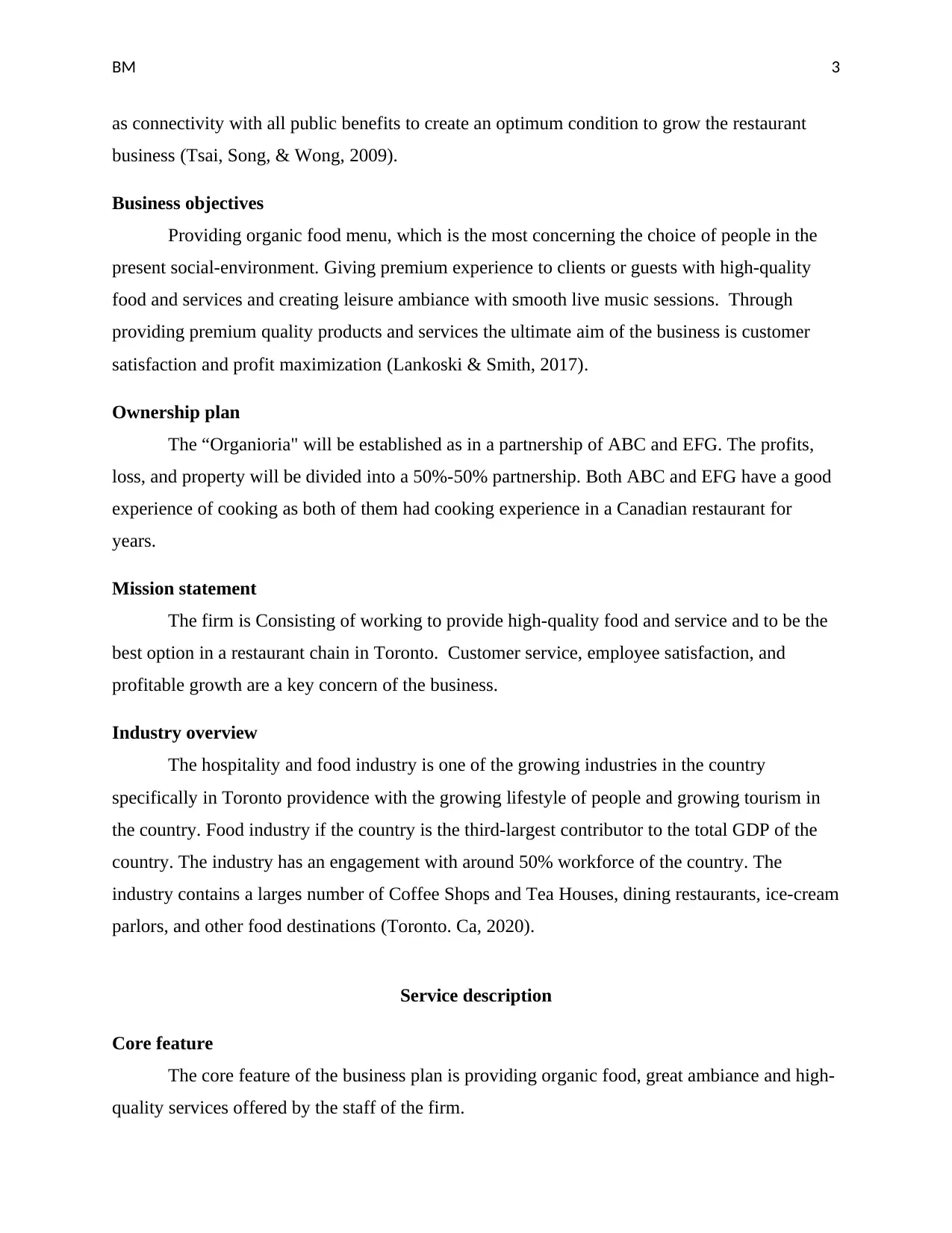
BM 3
as connectivity with all public benefits to create an optimum condition to grow the restaurant
business (Tsai, Song, & Wong, 2009).
Business objectives
Providing organic food menu, which is the most concerning the choice of people in the
present social-environment. Giving premium experience to clients or guests with high-quality
food and services and creating leisure ambiance with smooth live music sessions. Through
providing premium quality products and services the ultimate aim of the business is customer
satisfaction and profit maximization (Lankoski & Smith, 2017).
Ownership plan
The “Organioria" will be established as in a partnership of ABC and EFG. The profits,
loss, and property will be divided into a 50%-50% partnership. Both ABC and EFG have a good
experience of cooking as both of them had cooking experience in a Canadian restaurant for
years.
Mission statement
The firm is Consisting of working to provide high-quality food and service and to be the
best option in a restaurant chain in Toronto. Customer service, employee satisfaction, and
profitable growth are a key concern of the business.
Industry overview
The hospitality and food industry is one of the growing industries in the country
specifically in Toronto providence with the growing lifestyle of people and growing tourism in
the country. Food industry if the country is the third-largest contributor to the total GDP of the
country. The industry has an engagement with around 50% workforce of the country. The
industry contains a larges number of Coffee Shops and Tea Houses, dining restaurants, ice-cream
parlors, and other food destinations (Toronto. Ca, 2020).
Service description
Core feature
The core feature of the business plan is providing organic food, great ambiance and high-
quality services offered by the staff of the firm.
as connectivity with all public benefits to create an optimum condition to grow the restaurant
business (Tsai, Song, & Wong, 2009).
Business objectives
Providing organic food menu, which is the most concerning the choice of people in the
present social-environment. Giving premium experience to clients or guests with high-quality
food and services and creating leisure ambiance with smooth live music sessions. Through
providing premium quality products and services the ultimate aim of the business is customer
satisfaction and profit maximization (Lankoski & Smith, 2017).
Ownership plan
The “Organioria" will be established as in a partnership of ABC and EFG. The profits,
loss, and property will be divided into a 50%-50% partnership. Both ABC and EFG have a good
experience of cooking as both of them had cooking experience in a Canadian restaurant for
years.
Mission statement
The firm is Consisting of working to provide high-quality food and service and to be the
best option in a restaurant chain in Toronto. Customer service, employee satisfaction, and
profitable growth are a key concern of the business.
Industry overview
The hospitality and food industry is one of the growing industries in the country
specifically in Toronto providence with the growing lifestyle of people and growing tourism in
the country. Food industry if the country is the third-largest contributor to the total GDP of the
country. The industry has an engagement with around 50% workforce of the country. The
industry contains a larges number of Coffee Shops and Tea Houses, dining restaurants, ice-cream
parlors, and other food destinations (Toronto. Ca, 2020).
Service description
Core feature
The core feature of the business plan is providing organic food, great ambiance and high-
quality services offered by the staff of the firm.
Paraphrase This Document
Need a fresh take? Get an instant paraphrase of this document with our AI Paraphraser
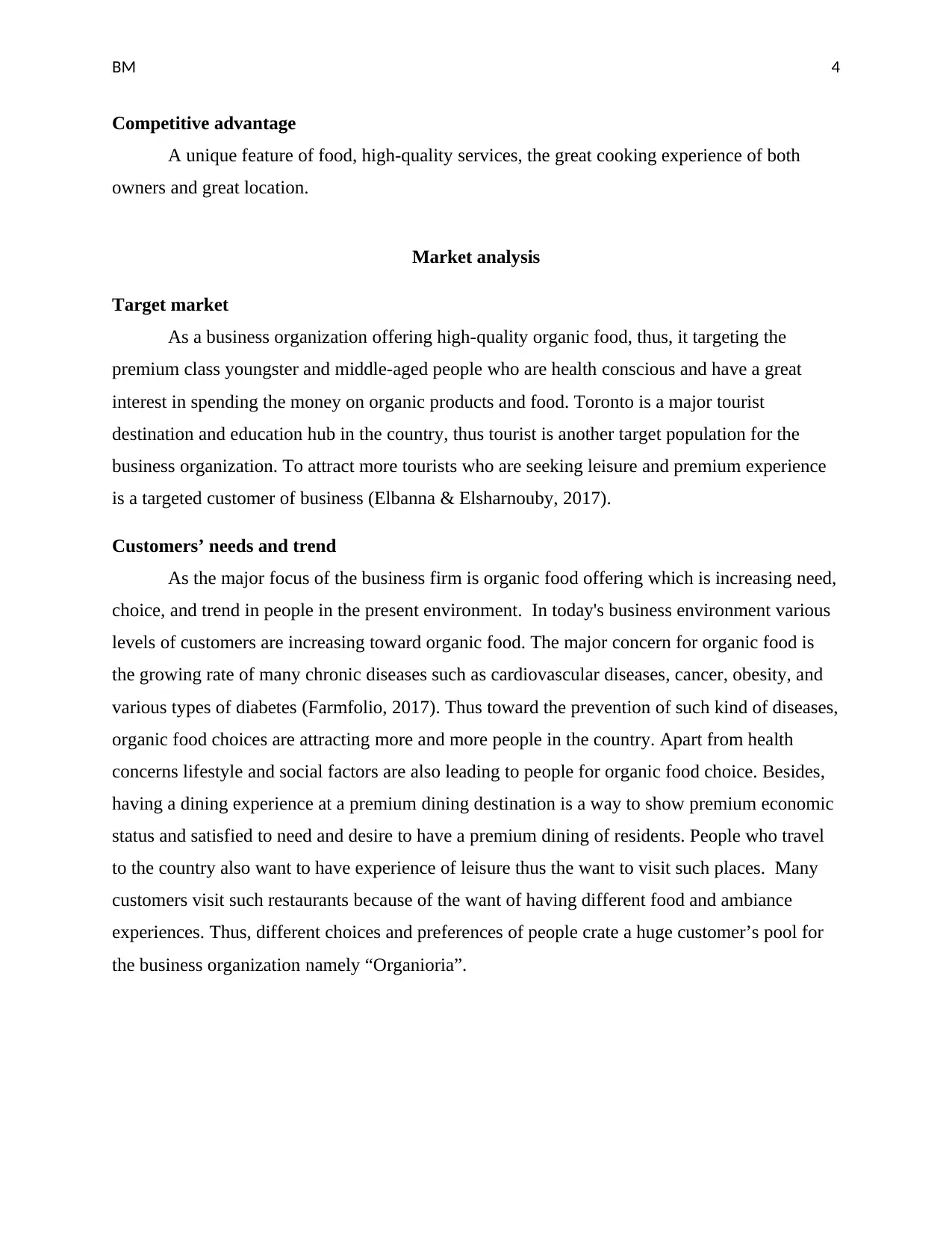
BM 4
Competitive advantage
A unique feature of food, high-quality services, the great cooking experience of both
owners and great location.
Market analysis
Target market
As a business organization offering high-quality organic food, thus, it targeting the
premium class youngster and middle-aged people who are health conscious and have a great
interest in spending the money on organic products and food. Toronto is a major tourist
destination and education hub in the country, thus tourist is another target population for the
business organization. To attract more tourists who are seeking leisure and premium experience
is a targeted customer of business (Elbanna & Elsharnouby, 2017).
Customers’ needs and trend
As the major focus of the business firm is organic food offering which is increasing need,
choice, and trend in people in the present environment. In today's business environment various
levels of customers are increasing toward organic food. The major concern for organic food is
the growing rate of many chronic diseases such as cardiovascular diseases, cancer, obesity, and
various types of diabetes (Farmfolio, 2017). Thus toward the prevention of such kind of diseases,
organic food choices are attracting more and more people in the country. Apart from health
concerns lifestyle and social factors are also leading to people for organic food choice. Besides,
having a dining experience at a premium dining destination is a way to show premium economic
status and satisfied to need and desire to have a premium dining of residents. People who travel
to the country also want to have experience of leisure thus the want to visit such places. Many
customers visit such restaurants because of the want of having different food and ambiance
experiences. Thus, different choices and preferences of people crate a huge customer’s pool for
the business organization namely “Organioria”.
Competitive advantage
A unique feature of food, high-quality services, the great cooking experience of both
owners and great location.
Market analysis
Target market
As a business organization offering high-quality organic food, thus, it targeting the
premium class youngster and middle-aged people who are health conscious and have a great
interest in spending the money on organic products and food. Toronto is a major tourist
destination and education hub in the country, thus tourist is another target population for the
business organization. To attract more tourists who are seeking leisure and premium experience
is a targeted customer of business (Elbanna & Elsharnouby, 2017).
Customers’ needs and trend
As the major focus of the business firm is organic food offering which is increasing need,
choice, and trend in people in the present environment. In today's business environment various
levels of customers are increasing toward organic food. The major concern for organic food is
the growing rate of many chronic diseases such as cardiovascular diseases, cancer, obesity, and
various types of diabetes (Farmfolio, 2017). Thus toward the prevention of such kind of diseases,
organic food choices are attracting more and more people in the country. Apart from health
concerns lifestyle and social factors are also leading to people for organic food choice. Besides,
having a dining experience at a premium dining destination is a way to show premium economic
status and satisfied to need and desire to have a premium dining of residents. People who travel
to the country also want to have experience of leisure thus the want to visit such places. Many
customers visit such restaurants because of the want of having different food and ambiance
experiences. Thus, different choices and preferences of people crate a huge customer’s pool for
the business organization namely “Organioria”.
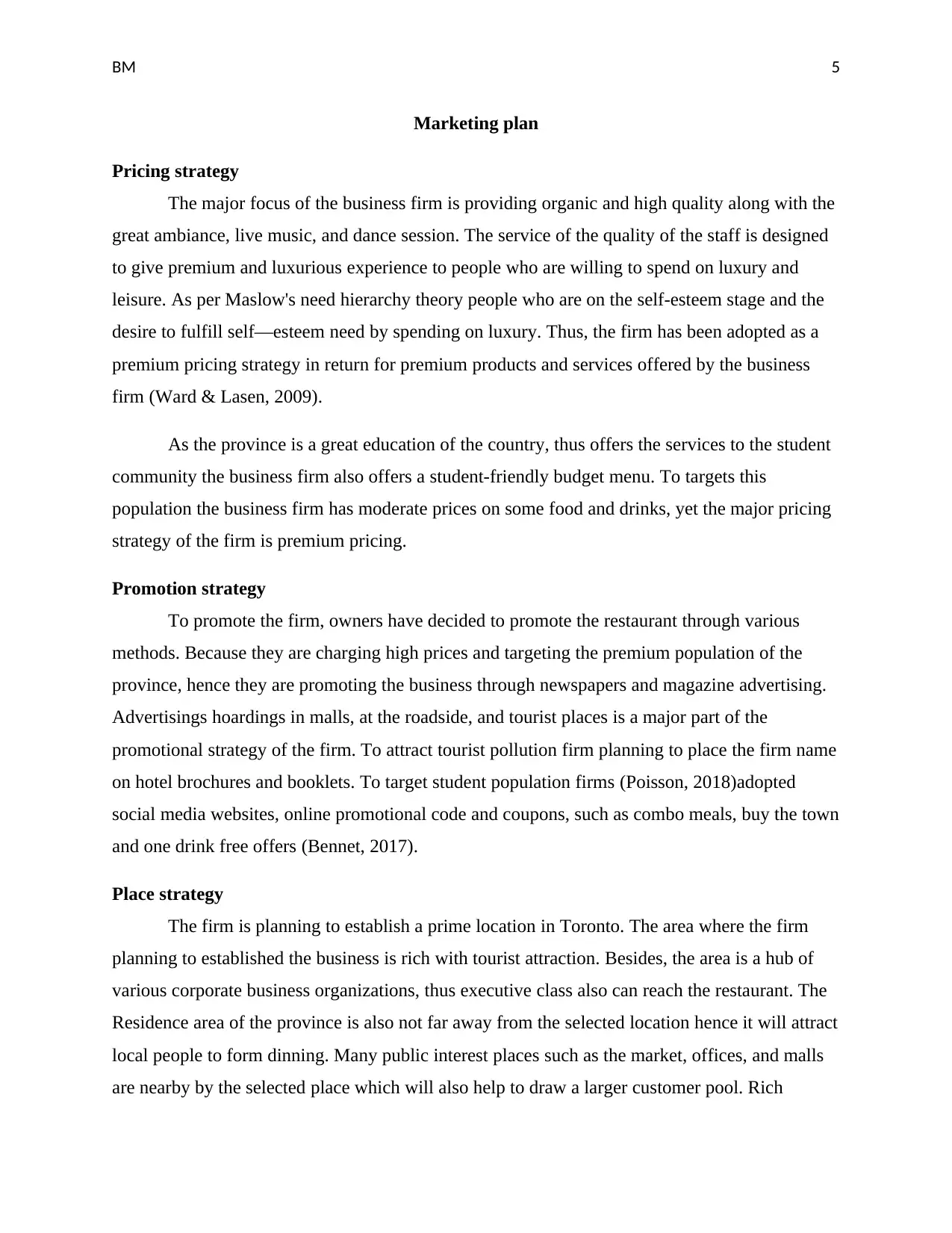
BM 5
Marketing plan
Pricing strategy
The major focus of the business firm is providing organic and high quality along with the
great ambiance, live music, and dance session. The service of the quality of the staff is designed
to give premium and luxurious experience to people who are willing to spend on luxury and
leisure. As per Maslow's need hierarchy theory people who are on the self-esteem stage and the
desire to fulfill self—esteem need by spending on luxury. Thus, the firm has been adopted as a
premium pricing strategy in return for premium products and services offered by the business
firm (Ward & Lasen, 2009).
As the province is a great education of the country, thus offers the services to the student
community the business firm also offers a student-friendly budget menu. To targets this
population the business firm has moderate prices on some food and drinks, yet the major pricing
strategy of the firm is premium pricing.
Promotion strategy
To promote the firm, owners have decided to promote the restaurant through various
methods. Because they are charging high prices and targeting the premium population of the
province, hence they are promoting the business through newspapers and magazine advertising.
Advertisings hoardings in malls, at the roadside, and tourist places is a major part of the
promotional strategy of the firm. To attract tourist pollution firm planning to place the firm name
on hotel brochures and booklets. To target student population firms (Poisson, 2018)adopted
social media websites, online promotional code and coupons, such as combo meals, buy the town
and one drink free offers (Bennet, 2017).
Place strategy
The firm is planning to establish a prime location in Toronto. The area where the firm
planning to established the business is rich with tourist attraction. Besides, the area is a hub of
various corporate business organizations, thus executive class also can reach the restaurant. The
Residence area of the province is also not far away from the selected location hence it will attract
local people to form dinning. Many public interest places such as the market, offices, and malls
are nearby by the selected place which will also help to draw a larger customer pool. Rich
Marketing plan
Pricing strategy
The major focus of the business firm is providing organic and high quality along with the
great ambiance, live music, and dance session. The service of the quality of the staff is designed
to give premium and luxurious experience to people who are willing to spend on luxury and
leisure. As per Maslow's need hierarchy theory people who are on the self-esteem stage and the
desire to fulfill self—esteem need by spending on luxury. Thus, the firm has been adopted as a
premium pricing strategy in return for premium products and services offered by the business
firm (Ward & Lasen, 2009).
As the province is a great education of the country, thus offers the services to the student
community the business firm also offers a student-friendly budget menu. To targets this
population the business firm has moderate prices on some food and drinks, yet the major pricing
strategy of the firm is premium pricing.
Promotion strategy
To promote the firm, owners have decided to promote the restaurant through various
methods. Because they are charging high prices and targeting the premium population of the
province, hence they are promoting the business through newspapers and magazine advertising.
Advertisings hoardings in malls, at the roadside, and tourist places is a major part of the
promotional strategy of the firm. To attract tourist pollution firm planning to place the firm name
on hotel brochures and booklets. To target student population firms (Poisson, 2018)adopted
social media websites, online promotional code and coupons, such as combo meals, buy the town
and one drink free offers (Bennet, 2017).
Place strategy
The firm is planning to establish a prime location in Toronto. The area where the firm
planning to established the business is rich with tourist attraction. Besides, the area is a hub of
various corporate business organizations, thus executive class also can reach the restaurant. The
Residence area of the province is also not far away from the selected location hence it will attract
local people to form dinning. Many public interest places such as the market, offices, and malls
are nearby by the selected place which will also help to draw a larger customer pool. Rich
⊘ This is a preview!⊘
Do you want full access?
Subscribe today to unlock all pages.

Trusted by 1+ million students worldwide
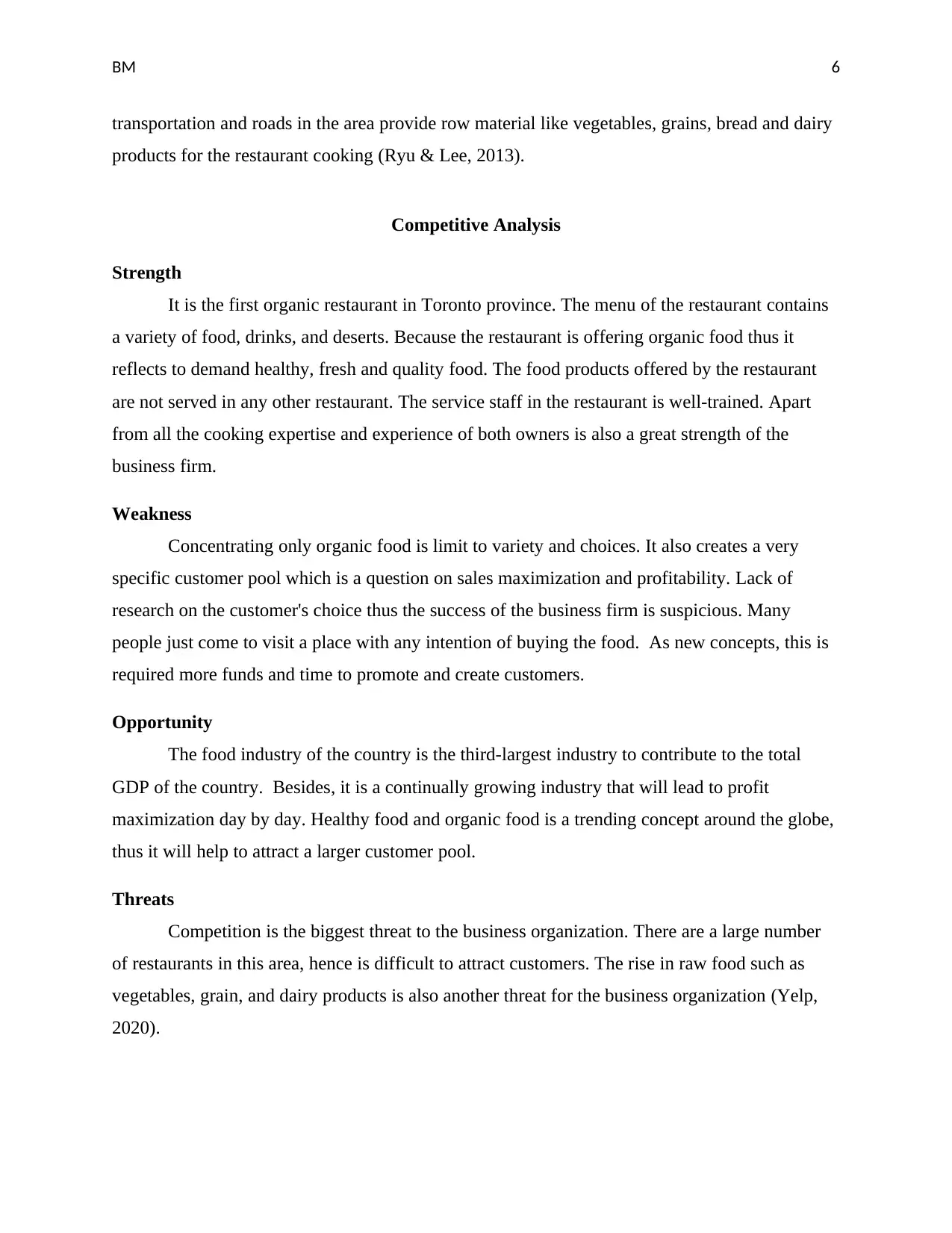
BM 6
transportation and roads in the area provide row material like vegetables, grains, bread and dairy
products for the restaurant cooking (Ryu & Lee, 2013).
Competitive Analysis
Strength
It is the first organic restaurant in Toronto province. The menu of the restaurant contains
a variety of food, drinks, and deserts. Because the restaurant is offering organic food thus it
reflects to demand healthy, fresh and quality food. The food products offered by the restaurant
are not served in any other restaurant. The service staff in the restaurant is well-trained. Apart
from all the cooking expertise and experience of both owners is also a great strength of the
business firm.
Weakness
Concentrating only organic food is limit to variety and choices. It also creates a very
specific customer pool which is a question on sales maximization and profitability. Lack of
research on the customer's choice thus the success of the business firm is suspicious. Many
people just come to visit a place with any intention of buying the food. As new concepts, this is
required more funds and time to promote and create customers.
Opportunity
The food industry of the country is the third-largest industry to contribute to the total
GDP of the country. Besides, it is a continually growing industry that will lead to profit
maximization day by day. Healthy food and organic food is a trending concept around the globe,
thus it will help to attract a larger customer pool.
Threats
Competition is the biggest threat to the business organization. There are a large number
of restaurants in this area, hence is difficult to attract customers. The rise in raw food such as
vegetables, grain, and dairy products is also another threat for the business organization (Yelp,
2020).
transportation and roads in the area provide row material like vegetables, grains, bread and dairy
products for the restaurant cooking (Ryu & Lee, 2013).
Competitive Analysis
Strength
It is the first organic restaurant in Toronto province. The menu of the restaurant contains
a variety of food, drinks, and deserts. Because the restaurant is offering organic food thus it
reflects to demand healthy, fresh and quality food. The food products offered by the restaurant
are not served in any other restaurant. The service staff in the restaurant is well-trained. Apart
from all the cooking expertise and experience of both owners is also a great strength of the
business firm.
Weakness
Concentrating only organic food is limit to variety and choices. It also creates a very
specific customer pool which is a question on sales maximization and profitability. Lack of
research on the customer's choice thus the success of the business firm is suspicious. Many
people just come to visit a place with any intention of buying the food. As new concepts, this is
required more funds and time to promote and create customers.
Opportunity
The food industry of the country is the third-largest industry to contribute to the total
GDP of the country. Besides, it is a continually growing industry that will lead to profit
maximization day by day. Healthy food and organic food is a trending concept around the globe,
thus it will help to attract a larger customer pool.
Threats
Competition is the biggest threat to the business organization. There are a large number
of restaurants in this area, hence is difficult to attract customers. The rise in raw food such as
vegetables, grain, and dairy products is also another threat for the business organization (Yelp,
2020).
Paraphrase This Document
Need a fresh take? Get an instant paraphrase of this document with our AI Paraphraser
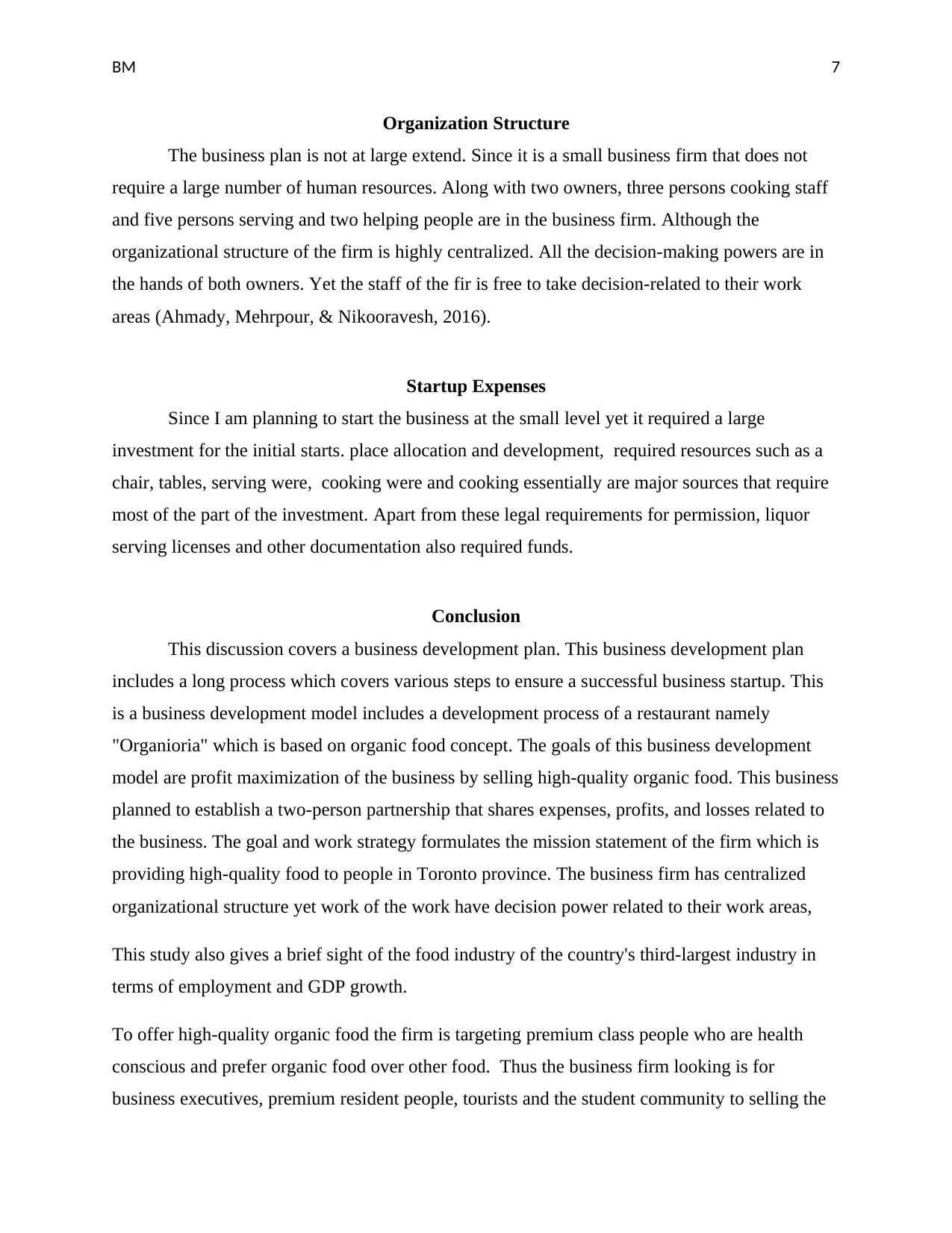
BM 7
Organization Structure
The business plan is not at large extend. Since it is a small business firm that does not
require a large number of human resources. Along with two owners, three persons cooking staff
and five persons serving and two helping people are in the business firm. Although the
organizational structure of the firm is highly centralized. All the decision-making powers are in
the hands of both owners. Yet the staff of the fir is free to take decision-related to their work
areas (Ahmady, Mehrpour, & Nikooravesh, 2016).
Startup Expenses
Since I am planning to start the business at the small level yet it required a large
investment for the initial starts. place allocation and development, required resources such as a
chair, tables, serving were, cooking were and cooking essentially are major sources that require
most of the part of the investment. Apart from these legal requirements for permission, liquor
serving licenses and other documentation also required funds.
Conclusion
This discussion covers a business development plan. This business development plan
includes a long process which covers various steps to ensure a successful business startup. This
is a business development model includes a development process of a restaurant namely
"Organioria" which is based on organic food concept. The goals of this business development
model are profit maximization of the business by selling high-quality organic food. This business
planned to establish a two-person partnership that shares expenses, profits, and losses related to
the business. The goal and work strategy formulates the mission statement of the firm which is
providing high-quality food to people in Toronto province. The business firm has centralized
organizational structure yet work of the work have decision power related to their work areas,
This study also gives a brief sight of the food industry of the country's third-largest industry in
terms of employment and GDP growth.
To offer high-quality organic food the firm is targeting premium class people who are health
conscious and prefer organic food over other food. Thus the business firm looking is for
business executives, premium resident people, tourists and the student community to selling the
Organization Structure
The business plan is not at large extend. Since it is a small business firm that does not
require a large number of human resources. Along with two owners, three persons cooking staff
and five persons serving and two helping people are in the business firm. Although the
organizational structure of the firm is highly centralized. All the decision-making powers are in
the hands of both owners. Yet the staff of the fir is free to take decision-related to their work
areas (Ahmady, Mehrpour, & Nikooravesh, 2016).
Startup Expenses
Since I am planning to start the business at the small level yet it required a large
investment for the initial starts. place allocation and development, required resources such as a
chair, tables, serving were, cooking were and cooking essentially are major sources that require
most of the part of the investment. Apart from these legal requirements for permission, liquor
serving licenses and other documentation also required funds.
Conclusion
This discussion covers a business development plan. This business development plan
includes a long process which covers various steps to ensure a successful business startup. This
is a business development model includes a development process of a restaurant namely
"Organioria" which is based on organic food concept. The goals of this business development
model are profit maximization of the business by selling high-quality organic food. This business
planned to establish a two-person partnership that shares expenses, profits, and losses related to
the business. The goal and work strategy formulates the mission statement of the firm which is
providing high-quality food to people in Toronto province. The business firm has centralized
organizational structure yet work of the work have decision power related to their work areas,
This study also gives a brief sight of the food industry of the country's third-largest industry in
terms of employment and GDP growth.
To offer high-quality organic food the firm is targeting premium class people who are health
conscious and prefer organic food over other food. Thus the business firm looking is for
business executives, premium resident people, tourists and the student community to selling the
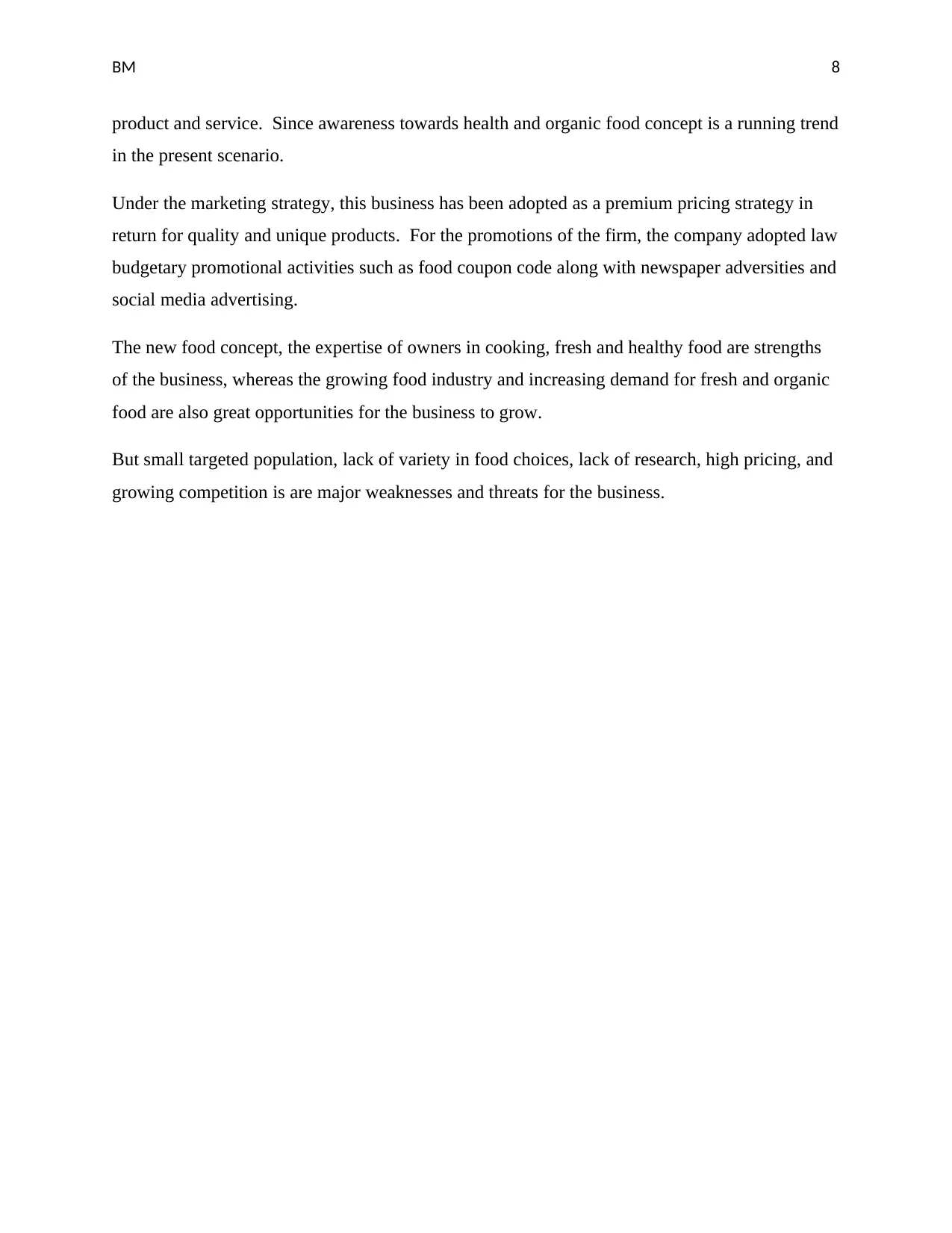
BM 8
product and service. Since awareness towards health and organic food concept is a running trend
in the present scenario.
Under the marketing strategy, this business has been adopted as a premium pricing strategy in
return for quality and unique products. For the promotions of the firm, the company adopted law
budgetary promotional activities such as food coupon code along with newspaper adversities and
social media advertising.
The new food concept, the expertise of owners in cooking, fresh and healthy food are strengths
of the business, whereas the growing food industry and increasing demand for fresh and organic
food are also great opportunities for the business to grow.
But small targeted population, lack of variety in food choices, lack of research, high pricing, and
growing competition is are major weaknesses and threats for the business.
product and service. Since awareness towards health and organic food concept is a running trend
in the present scenario.
Under the marketing strategy, this business has been adopted as a premium pricing strategy in
return for quality and unique products. For the promotions of the firm, the company adopted law
budgetary promotional activities such as food coupon code along with newspaper adversities and
social media advertising.
The new food concept, the expertise of owners in cooking, fresh and healthy food are strengths
of the business, whereas the growing food industry and increasing demand for fresh and organic
food are also great opportunities for the business to grow.
But small targeted population, lack of variety in food choices, lack of research, high pricing, and
growing competition is are major weaknesses and threats for the business.
⊘ This is a preview!⊘
Do you want full access?
Subscribe today to unlock all pages.

Trusted by 1+ million students worldwide
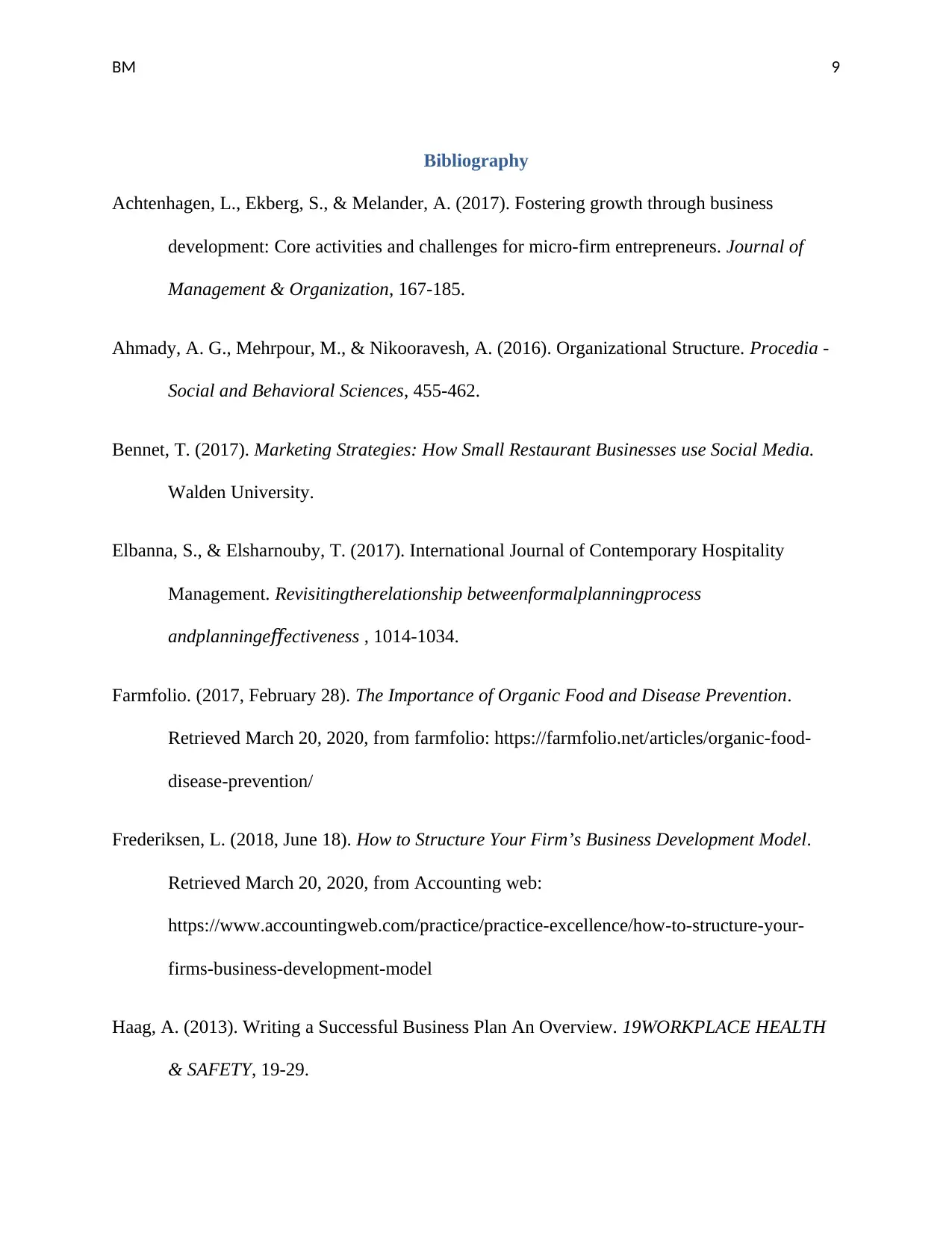
BM 9
Bibliography
Achtenhagen, L., Ekberg, S., & Melander, A. (2017). Fostering growth through business
development: Core activities and challenges for micro-firm entrepreneurs. Journal of
Management & Organization, 167-185.
Ahmady, A. G., Mehrpour, M., & Nikooravesh, A. (2016). Organizational Structure. Procedia -
Social and Behavioral Sciences, 455-462.
Bennet, T. (2017). Marketing Strategies: How Small Restaurant Businesses use Social Media.
Walden University.
Elbanna, S., & Elsharnouby, T. (2017). International Journal of Contemporary Hospitality
Management. Revisitingtherelationship betweenformalplanningprocess
andplanninge ectivenessff , 1014-1034.
Farmfolio. (2017, February 28). The Importance of Organic Food and Disease Prevention.
Retrieved March 20, 2020, from farmfolio: https://farmfolio.net/articles/organic-food-
disease-prevention/
Frederiksen, L. (2018, June 18). How to Structure Your Firm’s Business Development Model.
Retrieved March 20, 2020, from Accounting web:
https://www.accountingweb.com/practice/practice-excellence/how-to-structure-your-
firms-business-development-model
Haag, A. (2013). Writing a Successful Business Plan An Overview. 19WORKPLACE HEALTH
& SAFETY, 19-29.
Bibliography
Achtenhagen, L., Ekberg, S., & Melander, A. (2017). Fostering growth through business
development: Core activities and challenges for micro-firm entrepreneurs. Journal of
Management & Organization, 167-185.
Ahmady, A. G., Mehrpour, M., & Nikooravesh, A. (2016). Organizational Structure. Procedia -
Social and Behavioral Sciences, 455-462.
Bennet, T. (2017). Marketing Strategies: How Small Restaurant Businesses use Social Media.
Walden University.
Elbanna, S., & Elsharnouby, T. (2017). International Journal of Contemporary Hospitality
Management. Revisitingtherelationship betweenformalplanningprocess
andplanninge ectivenessff , 1014-1034.
Farmfolio. (2017, February 28). The Importance of Organic Food and Disease Prevention.
Retrieved March 20, 2020, from farmfolio: https://farmfolio.net/articles/organic-food-
disease-prevention/
Frederiksen, L. (2018, June 18). How to Structure Your Firm’s Business Development Model.
Retrieved March 20, 2020, from Accounting web:
https://www.accountingweb.com/practice/practice-excellence/how-to-structure-your-
firms-business-development-model
Haag, A. (2013). Writing a Successful Business Plan An Overview. 19WORKPLACE HEALTH
& SAFETY, 19-29.
Paraphrase This Document
Need a fresh take? Get an instant paraphrase of this document with our AI Paraphraser
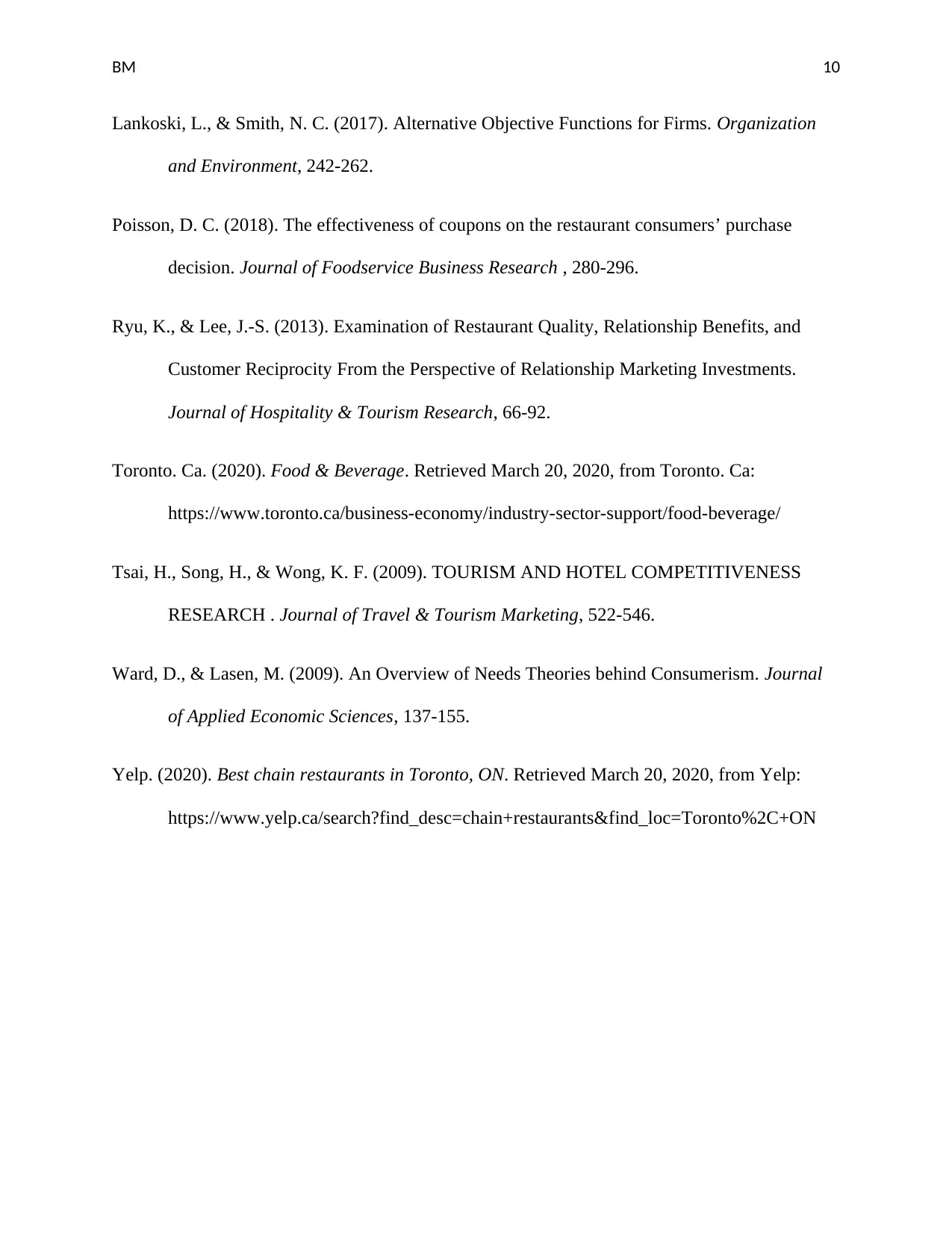
BM 10
Lankoski, L., & Smith, N. C. (2017). Alternative Objective Functions for Firms. Organization
and Environment, 242-262.
Poisson, D. C. (2018). The effectiveness of coupons on the restaurant consumers’ purchase
decision. Journal of Foodservice Business Research , 280-296.
Ryu, K., & Lee, J.-S. (2013). Examination of Restaurant Quality, Relationship Benefits, and
Customer Reciprocity From the Perspective of Relationship Marketing Investments.
Journal of Hospitality & Tourism Research, 66-92.
Toronto. Ca. (2020). Food & Beverage. Retrieved March 20, 2020, from Toronto. Ca:
https://www.toronto.ca/business-economy/industry-sector-support/food-beverage/
Tsai, H., Song, H., & Wong, K. F. (2009). TOURISM AND HOTEL COMPETITIVENESS
RESEARCH . Journal of Travel & Tourism Marketing, 522-546.
Ward, D., & Lasen, M. (2009). An Overview of Needs Theories behind Consumerism. Journal
of Applied Economic Sciences, 137-155.
Yelp. (2020). Best chain restaurants in Toronto, ON. Retrieved March 20, 2020, from Yelp:
https://www.yelp.ca/search?find_desc=chain+restaurants&find_loc=Toronto%2C+ON
Lankoski, L., & Smith, N. C. (2017). Alternative Objective Functions for Firms. Organization
and Environment, 242-262.
Poisson, D. C. (2018). The effectiveness of coupons on the restaurant consumers’ purchase
decision. Journal of Foodservice Business Research , 280-296.
Ryu, K., & Lee, J.-S. (2013). Examination of Restaurant Quality, Relationship Benefits, and
Customer Reciprocity From the Perspective of Relationship Marketing Investments.
Journal of Hospitality & Tourism Research, 66-92.
Toronto. Ca. (2020). Food & Beverage. Retrieved March 20, 2020, from Toronto. Ca:
https://www.toronto.ca/business-economy/industry-sector-support/food-beverage/
Tsai, H., Song, H., & Wong, K. F. (2009). TOURISM AND HOTEL COMPETITIVENESS
RESEARCH . Journal of Travel & Tourism Marketing, 522-546.
Ward, D., & Lasen, M. (2009). An Overview of Needs Theories behind Consumerism. Journal
of Applied Economic Sciences, 137-155.
Yelp. (2020). Best chain restaurants in Toronto, ON. Retrieved March 20, 2020, from Yelp:
https://www.yelp.ca/search?find_desc=chain+restaurants&find_loc=Toronto%2C+ON
1 out of 11
Related Documents
Your All-in-One AI-Powered Toolkit for Academic Success.
+13062052269
info@desklib.com
Available 24*7 on WhatsApp / Email
![[object Object]](/_next/static/media/star-bottom.7253800d.svg)
Unlock your academic potential
Copyright © 2020–2025 A2Z Services. All Rights Reserved. Developed and managed by ZUCOL.




